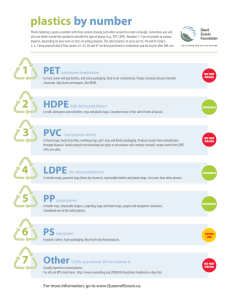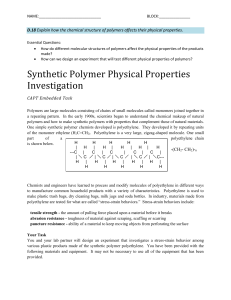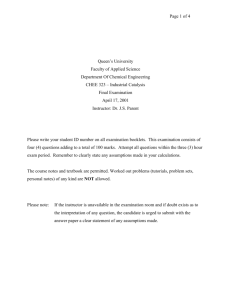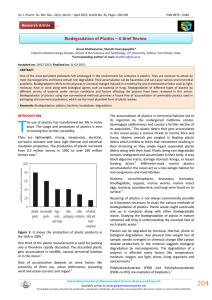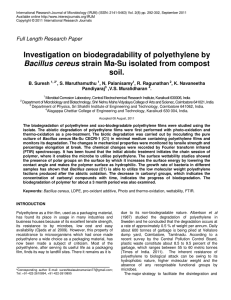Document 13309690
advertisement
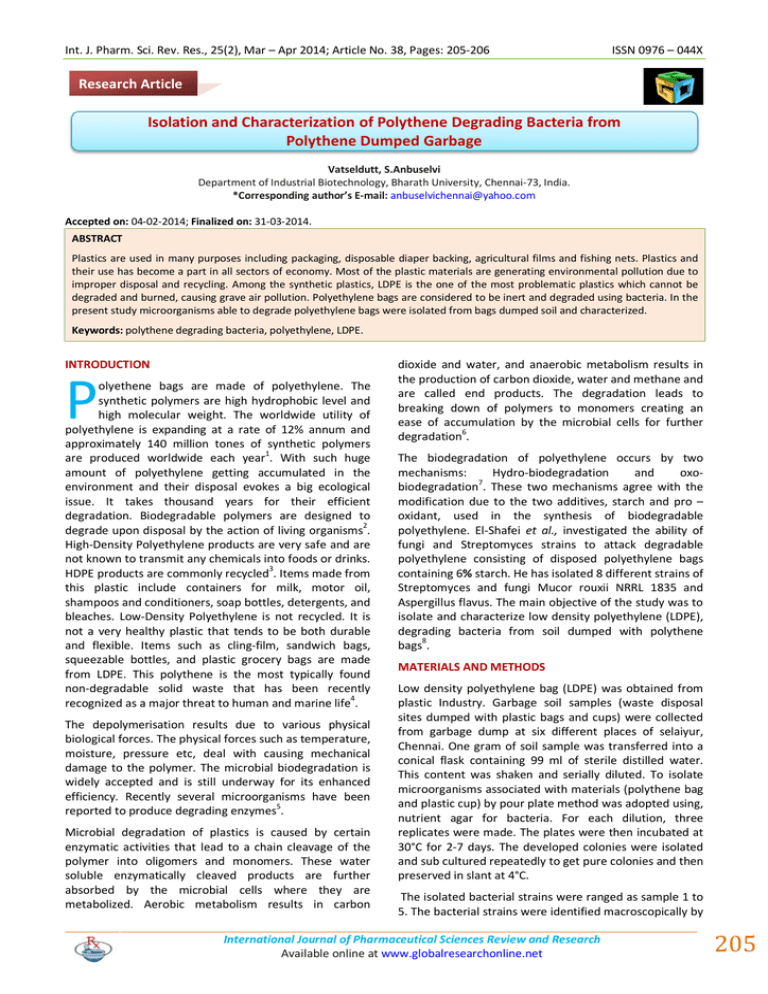
Int. J. Pharm. Sci. Rev. Res., 25(2), Mar – Apr 2014; Article No. 38, Pages: 205-206 ISSN 0976 – 044X Research Article Isolation and Characterization of Polythene Degrading Bacteria from Polythene Dumped Garbage Vatseldutt, S.Anbuselvi Department of Industrial Biotechnology, Bharath University, Chennai-73, India. *Corresponding author’s E-mail: anbuselvichennai@yahoo.com Accepted on: 04-02-2014; Finalized on: 31-03-2014. ABSTRACT Plastics are used in many purposes including packaging, disposable diaper backing, agricultural films and fishing nets. Plastics and their use has become a part in all sectors of economy. Most of the plastic materials are generating environmental pollution due to improper disposal and recycling. Among the synthetic plastics, LDPE is the one of the most problematic plastics which cannot be degraded and burned, causing grave air pollution. Polyethylene bags are considered to be inert and degraded using bacteria. In the present study microorganisms able to degrade polyethylene bags were isolated from bags dumped soil and characterized. Keywords: polythene degrading bacteria, polyethylene, LDPE. INTRODUCTION P olyethene bags are made of polyethylene. The synthetic polymers are high hydrophobic level and high molecular weight. The worldwide utility of polyethylene is expanding at a rate of 12% annum and approximately 140 million tones of synthetic polymers are produced worldwide each year1. With such huge amount of polyethylene getting accumulated in the environment and their disposal evokes a big ecological issue. It takes thousand years for their efficient degradation. Biodegradable polymers are designed to degrade upon disposal by the action of living organisms2. High-Density Polyethylene products are very safe and are not known to transmit any chemicals into foods or drinks. HDPE products are commonly recycled3. Items made from this plastic include containers for milk, motor oil, shampoos and conditioners, soap bottles, detergents, and bleaches. Low-Density Polyethylene is not recycled. It is not a very healthy plastic that tends to be both durable and flexible. Items such as cling-film, sandwich bags, squeezable bottles, and plastic grocery bags are made from LDPE. This polythene is the most typically found non-degradable solid waste that has been recently 4 recognized as a major threat to human and marine life . The depolymerisation results due to various physical biological forces. The physical forces such as temperature, moisture, pressure etc, deal with causing mechanical damage to the polymer. The microbial biodegradation is widely accepted and is still underway for its enhanced efficiency. Recently several microorganisms have been reported to produce degrading enzymes5. Microbial degradation of plastics is caused by certain enzymatic activities that lead to a chain cleavage of the polymer into oligomers and monomers. These water soluble enzymatically cleaved products are further absorbed by the microbial cells where they are metabolized. Aerobic metabolism results in carbon dioxide and water, and anaerobic metabolism results in the production of carbon dioxide, water and methane and are called end products. The degradation leads to breaking down of polymers to monomers creating an ease of accumulation by the microbial cells for further degradation6. The biodegradation of polyethylene occurs by two mechanisms: Hydro-biodegradation and oxo7 biodegradation . These two mechanisms agree with the modification due to the two additives, starch and pro – oxidant, used in the synthesis of biodegradable polyethylene. El-Shafei et al., investigated the ability of fungi and Streptomyces strains to attack degradable polyethylene consisting of disposed polyethylene bags containing 6% starch. He has isolated 8 different strains of Streptomyces and fungi Mucor rouxii NRRL 1835 and Aspergillus flavus. The main objective of the study was to isolate and characterize low density polyethylene (LDPE), degrading bacteria from soil dumped with polythene bags8. MATERIALS AND METHODS Low density polyethylene bag (LDPE) was obtained from plastic Industry. Garbage soil samples (waste disposal sites dumped with plastic bags and cups) were collected from garbage dump at six different places of selaiyur, Chennai. One gram of soil sample was transferred into a conical flask containing 99 ml of sterile distilled water. This content was shaken and serially diluted. To isolate microorganisms associated with materials (polythene bag and plastic cup) by pour plate method was adopted using, nutrient agar for bacteria. For each dilution, three replicates were made. The plates were then incubated at 30°C for 2-7 days. The developed colonies were isolated and sub cultured repeatedly to get pure colonies and then preserved in slant at 4°C. The isolated bacterial strains were ranged as sample 1 to 5. The bacterial strains were identified macroscopically by International Journal of Pharmaceutical Sciences Review and Research Available online at www.globalresearchonline.net 205 Int. J. Pharm. Sci. Rev. Res., 25(2), Mar – Apr 2014; Article No. 38, Pages: 205-206 examining colony morphology, surface pigment, shape and size on nutrient agar plates. Microscopic examination including Gram’s staining is used to study the staining behavior, shape and cell arrangement. Motility test was also performed. Further characterization was confirmed by performing the following biochemical tests such as catalase, gelatin hydrolysis, triple sugar, indole, methyl red, VP, starch, citrate and motility tests and following the procedures described in Bergey's manual and Murray et al. RESULTS AND DISUSSION ISSN 0976 – 044X changes in mechanical properties of tensile strength, optical changes of cracking, erosion and decolourization9. It is clear that natural polymers can be degraded to some extent by microbes. The biodegradation of plastics by isolated bacteria showed clear zone (Fig 1). It implies the initiation of biodegradation. Maximum degradation was found to be by staphylococcus species and the minimum degradation was found to be by pseudomonas species. Staphylococcus showed 52% degradation and pseudomonas showed 11% degradation by weight loss. These microbes confirmed its polyethylene degradation. Five different samples were identified by micro and macroscopically and confirmed by various biochemical tests. Based on the colony morphology, gram staining, biochemical tests, and motility test (Table1) five different strains were identified. The identified strains were E.coli, staphylococcus, pseudomonas, Klebsiella and bacillus. The isolated microorganisms from polyethylene dumped areas can be interacted with polyethene and undergo Figure 1: Zone of clearance observed on plates isolated with bacterial strains containing polythene strips Table 1: Characteristics of bacterial cultures and its identification Biochemical test E.coli Staphylococcus Pseudomonas klebsiella Bacillus Catalase Test + + + + + Gelatin hydrolysis test + _ _ _ + Indole Test + _ _ _ _ Methyl red test + _ _ _ _ Voges-proskauer test _ + _ _ + Starch hydrolysis test _ _ _ + + Citrate utilization test _ + _ + _ Motility Test + _ + _ + CONCLUSION The bacterial colonies were identified as E.Coli, pseudomonas, Klebsiella and bacillus. Staphylococcus was found to be very effective and less amount of biodegradation was observed in Pseudomonas. These microbes are native to the site of low density polyethylene and they exhibit its degradation on culture media. REFERENCES 1. Shimao M, Biodegradation of Curr.Opin.Biotechnol, 12, 2001, 242-247. 2. Potts JE, Jelink HHG, Biodegradation Aspects of biodegradation & stabilization of Polymers. Elsevier, New York, 1978, 617-658. 3. Scott G., Polymer in modern life. In: Polymers andEnvironment, The royal Society of Chemistry, Cambridge, UK, 1999. 4. Sudesh K, Abe H, Doi Y, Components characterization of LDPE blown film samples used in biodegradation. Interesjournals.org, 2007, 28-35. 5. Tokiwa Y, Calabia BP, Degradation of microbial polyesters Biotechnol Lett, 2004, 53, 1181–1189. 6. Kathiresan K., Polythene and Plastics degrading microbesfrom the mangrove soil, Rev. Biol.Trop, 51(3), 2004, 629-634. 7. Bonhomme S, Cuer A, Delort AM, Lemaire J, Sancelme M, Scott C. Environmental biodegradation of polyethylene. Polym Degrad Stab , 81, 2003, 441–52. 8. EI-Shafei H, EI-Nasser NHA, Kansoh AL, Ali AM. Biodegradation of disposable polyethylene by fungi Streptomyces species. Polym Degrad Stab, 62, 1998, 361– 5. 9. Gu JD, Microbiological deterioration and degradation of synthetic polymeric materials: recent research advances. Int Biodeterior Biodegrad, 52, 2003, 69–91. plastics. Source of Support: Nil, Conflict of Interest: None. International Journal of Pharmaceutical Sciences Review and Research Available online at www.globalresearchonline.net 206

